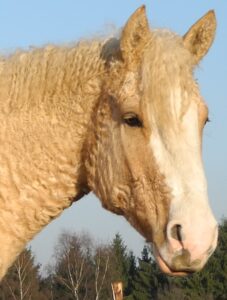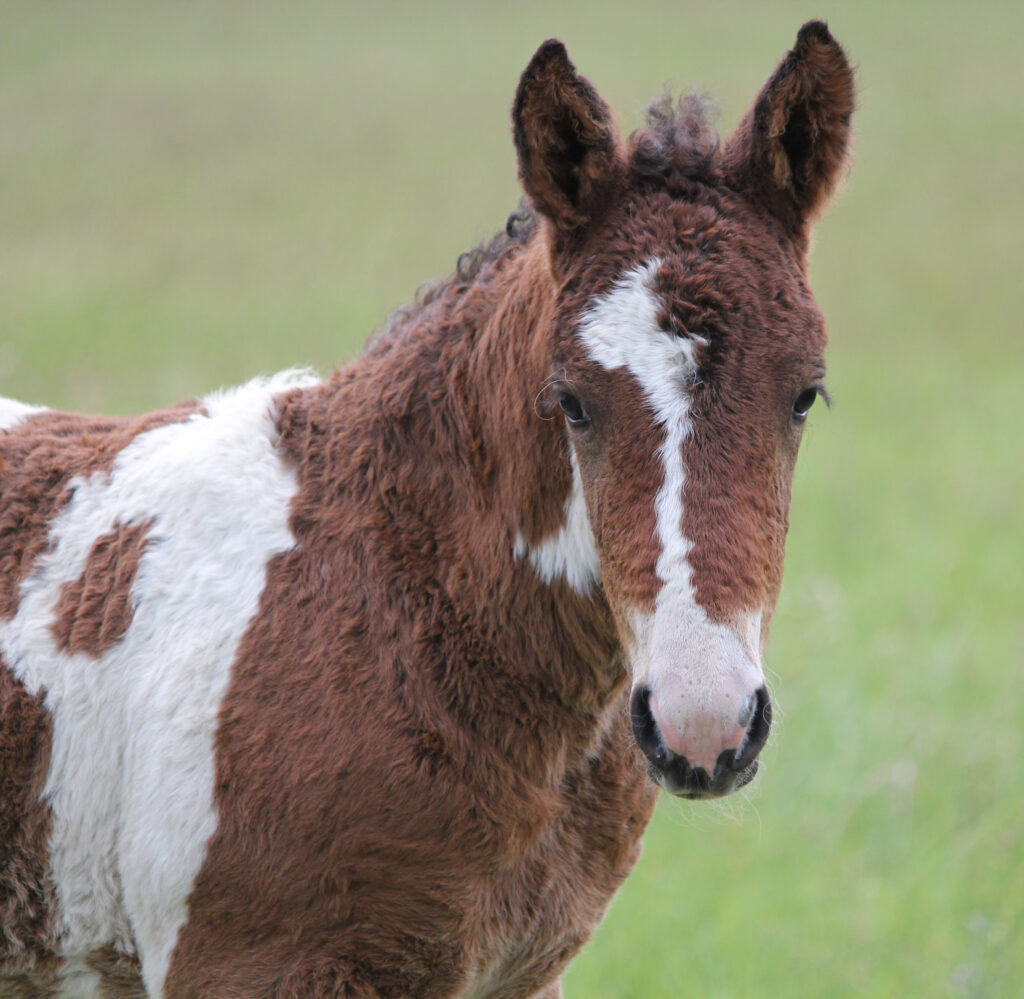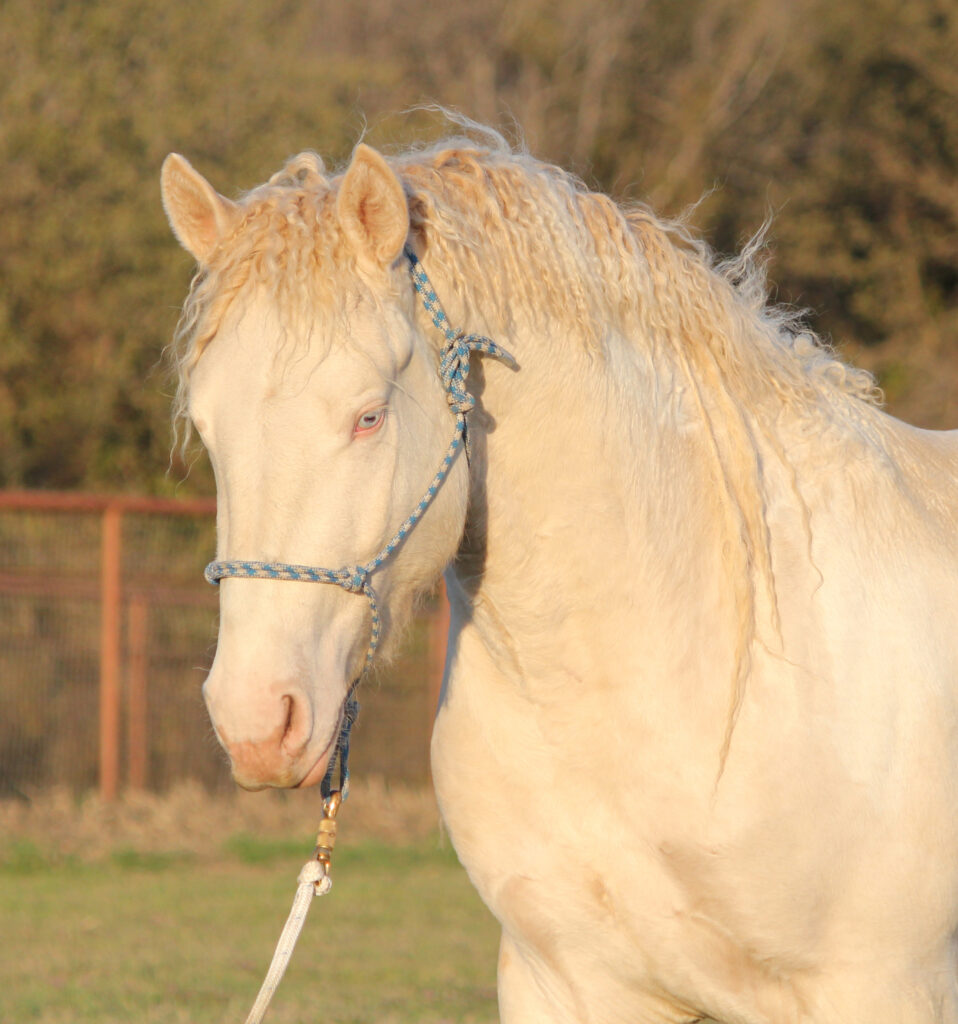
Courtesy of Caren & Peter Schumann 
Courtesy of Stag Creek Farm 
Courtesy of Stag Creek Farm
The exact origin of the Bashkir Curly Horse is one of the greatest mysteries of the horse world.
Horses with curly coats are most certainly an ancient breed. They have been depicted in art and statuary in early China as far back as 161 AD. There has been evidence of their presence in South America and Europe.
A photo of a curly coated Bashkir horse from Russia was printed in the 1938 March issue of the Nature magazine entitled “The Evolution of the Horses”. The horse’s picture was later drawn by John Hix and featured in a cartoon called “Strange as it Seems”. The clipping had been saved in a scrapbook by the Damele (Duh-mel’ly) family (early day curly horse breeders in Nevada). This information was one of the factors that helped in determining the name of this unique breed, the American Bashkir Curly Horse.
It is still a mystery how the Curlies came to the US. But there is evidence that Curlies have been in North America since the early 1800’s. Many Indian pictographs illustrating the “Winter Counts” have noted that in the winter of 1801-1802 the Sioux had stolen some curly horses from the Crow. This incident placed the tribes at the Standing Rock/Cheyenne River Reservation at the mouth of the Grand River.
A significant location of the Curlies today has been traced to Indian Reservations in North and South Dakota. Many Curlies then and now have been acquired from the wild horses that roam the lands of the United States.
One theory why curly coated horses ended up roaming with the wild mustangs of the West, was that the Russian Bashkir Curly horses, that were originally shipped with the Russian colonist who tried to settle America’s Northwest territory during the 1700’s, had set their remaining horses free after abandoning their westward expansion. Unfortunately, through further research including consultations with Russian scientists, the Moscow Zoo and the Ministry of Agriculture, it was determined that there are no curly haired horses from the Bashkir region.
Another theory is that the ancestor of the Bashkir Curly Horse might have crossed the land bridge during the last Ice Age. But there is no fossil evidence to support the existence of horses in the America’s from the last Ice Age until the reintroduction of horses to this hemisphere by the Spanish.
Formation of the American Bashkir Curly Horse Breed
Fortunately, more is known about the development of the modern Bashkir Curly Horse.
The modern day history of American Bashkir Curly dates to 1898, when young Peter Damele and his father were riding the Peter Hanson Mountains in the remote high country of Central Nevada, near Austin. Peter recalled seeing three horses with tight curly ringlets over their entire bodies. It was intriguing to both father and son as to where these horses had come from and just why they were there, questions that as you can see are still not answered. However, from that day to this, there have always been curly-coated horses on the Damele range. Many of the Bashkir Curly Horses in the U.S. can be traced back to the Damele herd.
Establishing The American Bashkir Curly Horse Registry in 1971, the founders set out to save these animals from extinction in the U.S., as it was found that too many of them, through ignorance, were being slaughtered. They then began the process of establishing breeding traits. To accomplish this, owners were asked to list the characteristics unique to the Bashkir Curly Horse. When compiled these brought out several interesting features of the breed.
Curly Conformation
Bashkir Curly Horse’s appear in all common horse colors including Appaloosa and Pinto. Curlies somewhat resemble the early day Morgan in conformation and a number of traits have been found in this unique breed that link them to the primitive horse. Curlies are of medium size. Their soft, calm looking eyes have an unusual Oriental slant to them, which gives them a sort of sleepy look, but which also tends to give them a larger range of vision to the rear. The sleepy look is very deceiving, as they have a proud carriage, are very alert and not lazy and most move at a running walk.
Their unusually tough black hoofs are almost perfectly round in shape. Many Curlies with white legs will still have four black hoofs. They also have stout roundbone cannons; straight legs that also move straight; flat knees; strong hocks; short back which indicates five lumbar vertebrae; round rump without crease or dimple; powerful rounded shoulders; V’d chest and round barrel, all of which contribute to their strength and endurance.
The foals arrive with thick, crinkly coats almost resembling astrakhan (‘as-tra-kan) wool, even inside their short broad ears, and also have beautiful curly eyelashes. They are born with an unusually affectionate disposition and insist on being friendly. When excited or at play, the foals move at a bold trot with their tails absolutely straight in the air.
They have a double mane which splits down the middle leaving curly ringlets hanging on both sides of the neck. Their body coat sheds out in the summer and they become wavy or fairly straight on their body, with their beautiful coat returning in the late fall. Several winter coat patterns have been observed, from a crushed velvet effect, to a perfect marcel (mar-‘sel) wave, to extremely tight curls over the entire body. It has been tested and proven that flat hair is curly, yet when the hair of the Curlies was tested it was found to be round. One other thing about their hair that should be mentioned is that a number of owners who are allergic to horses find that they are not allergic to their Curlies.
The Bashkir Curly Horse is a hardy breed and able to survive severe winter conditions. In the winter of 1951-52, the Curly horses were the only ones to survive on the open ranges of Nevada without supplemental feeding.
Their most cherished quality is their calmness and extremely gentle disposition. We do feel that this is one of their finest features. Many have been taken off the open range, even full grown animals, and in a day or two, they are gentler than horses that have been handled for years. Nothing seems to ruffle them. They do not tend to resort too flight when frightened, which has been claimed the horse’s greatest means of survival. Curlies, with their naturally curious nature, prefer to face the unknown rather than run from it. If they feel something is a real danger to them, they prefer to kick rather than run. Although they will struggle frantically when first roped or haltered, they soon respond to kindness and affection because of their inherent gentle nature. They seem unable to cope with or tolerate abuse. They will tend to freeze in a tight spot so seldom get themselves hurt, even if caught in barbed wire. They will delight in human companionship and love to be talked to.
Performance wise, Curlies are a no-nonsense horse and have an uncanny ability to do all that is asked of them since they are usually intelligent, learn quickly and a remarkable memory (for either good or bad experiences) They have won trophies in arena events such as: Western Riding, Reining, Gymkhana Events, Hunter, Jumper, Roping, English Equitation, Western Pleasure, Gaited Pleasure, Dressage and Driving. They have won in Competitive and Endurance Trail Riding and are excellent mounts in the mountains, ranch work and all round pleasure horse.